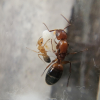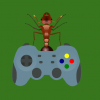Because I'm very confused about the alates and eggs in my queenless Dorymyrmex bureni colony (read about that colony here) I've been reading everything I can find about these ants online. Sadly, there is a lot of misinformation about ants online. Much of it is on websites run by exterminators, but now with "AI Generated" content there are even more incorrect and just strange sources. But, the first incorrect information about Dorymyrmex bureni I would encounter was on a university website!
First of all, some background: Dorymyrmex bureni are tiny, highly active light brown/yellow ants. They do not sting and can't bite human skin effectively due to being small. They do not generally respond to their nest being disturbed by trying to bite a large animal like a human. They run away, carrying their brood and sisters. Since they are super fast, this is effective. They do not typically infest human dwellings, they like to live in sandy soil with lots of sun exposure. Any ant that lives in hot sandy soil down south in the USA is a potential buffer species for the invasive fire ants Solenopsis invicta.
"We have observed this species to attack workers and especially newly mated queens of the imported fire ants, the bodies of which are then often scattered around the crater of the Dorymyrmex colony."
https://mississippie...rmex.bureni.htm
These are the things I know about these ants from study and experience. .. so why would Dorymyrmex bureni be on lists of "pests" with directions for killing them?
"Colonies found under items on the ground can be drenched with a few ounces of insecticide." (TA&MU recommendation for "treating" Dorymyrmex bureni)
Very disappointed to see that TA&MU is recommending "treating" Dorymyrmex bureni ant colonies. I wonder what other beneficial native insects are also on the kill list of the Agricultural & Life Sciences website. Further, based on how they describe the ants, I don't even think they have identified them correctly. To be fair it, sounds like some species of Dorymyrmex... but it's odd that they'd be that far west and there are no observations in iNaturalist in that area.
"Color combinations: Reddish-black head and thorax – black abdomen Red head and thorax – black abdomen" (TA&MU)
This is totally wrong. bureni is light brown/ yellow orange. There is a photo of an ant on TA&MU's website and I don't know if it is Dorymyrmex bureni, it appears to be some other Dorymyrmex sp. ... possibly bicolor.
Searching the web more I found more misinformation I found several sites that claimed that Dorymyrmex ants are "aggressive" and have a "painful bite" -- perhaps these were written by small hapless garden spiders and young crickets? I can't image anyone calling the failed attempts at biting from these tiny ants painful.
I've realized that I need to go to a real library. Researching ants online has limitations. There are many pages that are just totally incorrect and it's disturbing.




















